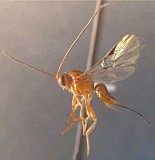Psyttalia cosyrae (Wilkinson, 1927)
Remarks
Taxonomic History / Nomenclature
Thsi species was originally described as Opius cosyrae by Wilkinson (1927).
Fischer (1987) later included this species in the Opius subgenus Psyttalia.
Psyttalia was subsequently elevated to generic rank by Wharton (1987).
The combination Psyttalia cosyrae (Wilkinson) was first used by Wharton (1989).
Fischer (1987) later included this species in the Opius subgenus Psyttalia.
Psyttalia was subsequently elevated to generic rank by Wharton (1987).
The combination Psyttalia cosyrae (Wilkinson) was first used by Wharton (1989).
Description
This species is similar to Psyttalia concolor, but has a distinctly longer ovipositor.
Distribution
Afrotropics
Distribution
Native
Africa (Greathead, D. J. 1972.)
Congo (Fischer, M. 1963.; Fischer, M. 1974.)
Reunion (. 0.)
Nigeria (Fischer, M. 1973.; Papp, J. 1985.)
Sierra Leone (Fischer, M. 1973.; Papp, J. 1985.)
South Africa (Fischer, M. 1973.; Papp, J. 1985.)
Eastern Cape (Fischer, M. 1973.)
Zaire (Papp, J. 1985.)
Identification of Species and Subspecies
Psyttalia cosyrae was included in a morphometric analysis of various Kenyan populations of Psyttalia capable of successfully developing on medfly, Ceratitis capitata (Kimani-Njogu et al. (2001)). Rugman-Jones et al. (2009), using molecular data, compared a broader selection of Psyttalia populations, and included P. cosyrae from Kenya and Benin.
Under laboratory conditions, Psyttalia cosyrae is capable of producing viable, female offspring through several generations when hybridized with Psyttalia concolor.
At least some (and maybe most) of the material introduced to Hawaii in the 1930s and 1940s from East Africa under the names perproximus and phaeostigma was actually Psyttalia cosyrae (Wharton and Gilstrap 1983).
Biology / Hosts
Psyttalia cosyrae has been reared from Ceratitis cosyra infesting mangoes and a few wild host plants in Kenya and Tanzania (Wilkinson 1927, Copeland et al. 2006, Copeland et al. 2009). It has also been reared from mangoes in Mali (Vayssieres et al. 2002).
Biology and Behavior
Oviposits preferentially in later instar larvae of its host (Mohamed et al. 2003, 2006).
Biology - Host Range Testing
Information on Psyttalia cosyrae was published by Mohamed et al. (2003, 2006). Mohamed et al. (2003) demonstrated it’s ability to attack and successfully develop in Ceratitis cosyrae and C. capitata (medfly) in the laboratory. It was encapsulated by C. rosa, C. fasciventris, C. anonae, and Bactrocera cucurbitae.


